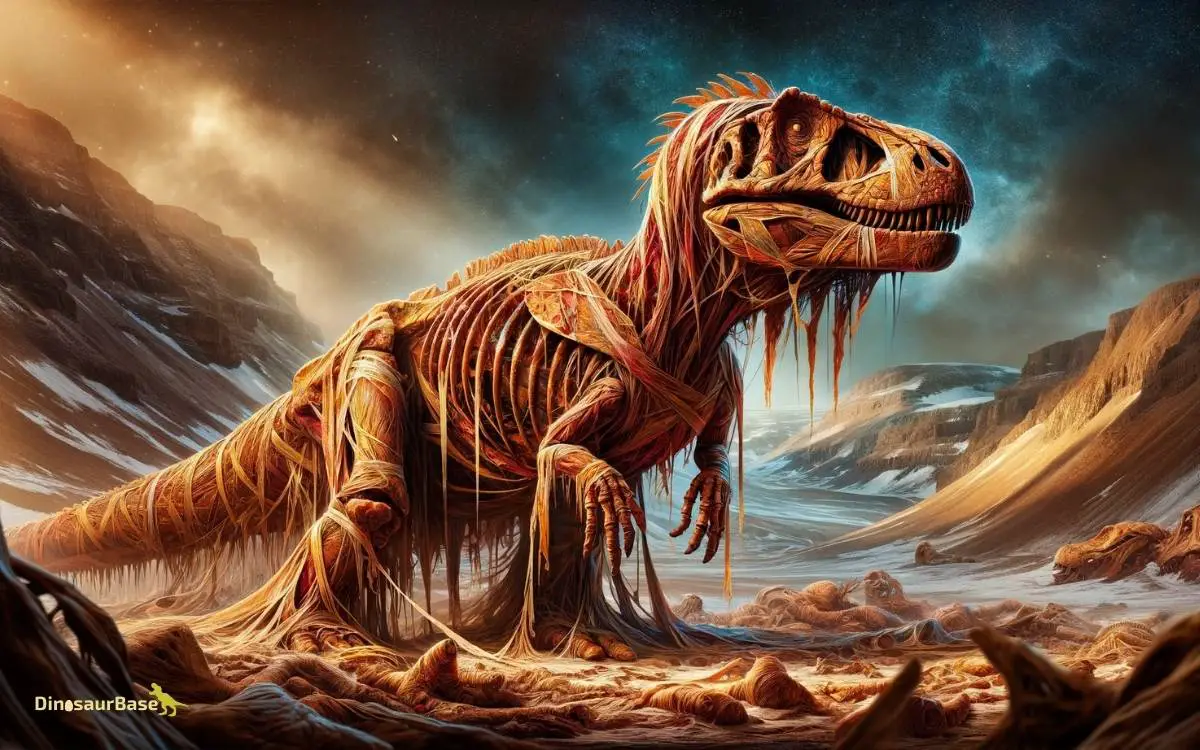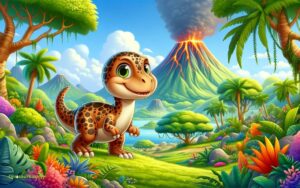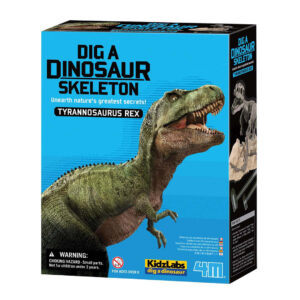7 Fascinating Facts About the Dinosaur Mummy Found in Canada
In 2011, a remarkable dinosaur mummy was unearthed in Alberta, Canada, showcasing skin, armor, and even some internal organs preserved.
This ‘mummified’ nodosaur is over 110 million years old and is one of the best-preserved dinosaur specimens ever discovered.
The discovery of the dinosaur mummy in Canada has ignited the imaginations of paleontologists and dinosaur enthusiasts alike.
This stunning fossilized specimen offers an unprecedented glimpse into the prehistoric world, bringing a dinosaur’s physical form to light in astonishing detail.
The nodosaur, a type of armored plant-eating dinosaur, was found in Alberta’s oil sands, a location that has become a hotspot for significant paleontological finds.
The level of preservation is so extraordinary that the dinosaur appears almost as it would have in life, providing an invaluable resource for scientific study.
Its discovery not only opens a new window into the Cretaceous period but also serves as a tangible link to a time when these colossal creatures roamed the Earth.

Unearthing The Dinosaur Mummy
In 2011, miners in Alberta, Canada, made a groundbreaking discovery. They uncovered something beyond the usual fossils.
This was no ordinary find. Instead, it was a dinosaur mummy, with skin, scales, and possibly even its entrails preserved through the eons.
Discovery Of A Lifetime
Dug up in the Millennium Mine, this dinosaur mummy stunned the world. Not only were the bones intact, but also soft tissues like the skin, creating a three-dimensional view into the past. It offered a glimpse of what the 110-million-year-old creature looked like.
Experts identified it as a Nodosaur, a type of armored dinosaur. Thanks to this rare preservation, it provides exceptional insights into dinosaur biology and behavior. The find was one of the best-preserved dinosaurs ever discovered.
The Site’s Geological Richness
Alberta, Canada, is known for its rich fossil heritage. Specifically, the location where the dinosaur was found is a part of the Bearpaw Formation. This geological goldmine dates back to the Cretaceous period.
- Region known for marine sediments and prehistoric fauna.
- Site’s preservation capabilities are remarkable due to mineral-rich soil.
- Has produced numerous dinosaur skeletons and rare soft-tissue fossils.
This area’s unique conditions created a perfect storm for preservation, allowing experts to study dinosaurs in unprecedented detail.
An Intact Cretaceous Creature
In 2011, the winds of the Millennium Mine unveiled an astonishing discovery. Miners unearthed a prehistoric figure, seemingly straight from a fantasy book.
This ‘dinosaur mummy,’ as it’s affectionately known, is not your typical fossil. Instead of bones, this specimen offers a rare glimpse into the dinosaur’s skin, armor, and even its last meal. Let’s unearth some of the fascinating aspects of this Cretaceous-era marvel.
Exceptional Preservation
- Not just bones: Unlike most dinosaur remains, this mummy includes skin, scales, and soft tissues.
- Mummified in minerals: A process called permineralization preserved the dinosaur in stunning detail.
- 3D fossil: You can see the creature’s physical form in three dimensions. It’s as if it just lay down to rest.
- Remarkably complete: Over 90% of the body was recovered. This is rare for any dinosaur fossil.
Species And Age Identification
| Name: | Nodosaurus textilis |
| Age: | Approximately 110 million years |
| Period: | Late Cretaceous |
| Size: | About 5 meters long |
| Discovery: | 2011, Millennium Mine, Canada |
The Nodosaurus textilis once thrived in what is now Canada. Experts have estimated that it roamed the Earth 110 million years ago. At about 5 meters in length, the dinosaur was a formidable presence in the Cretaceous period.
Revelation Of Skin And Armor
The discovery of a dinosaur mummy in Canada has provided scientists with an exceptional opportunity to study dinosaur skin and armor in stunning detail.
This remarkable specimen, unearthed with both skin and armor intact, serves as a window into the fascinating world of dinosaurs like never before.
Unprecedented Skin Details
Paleontologists were astounded by the immaculate preservation of the dinosaur’s skin. This find presents one-of-a-kind insights into:
- The texture and complexion of dinosaur skin.
- Patterns and scales that have never been observed with such clarity.
- How the skin may have helped the dinosaur blend with its environment.
Details like these are vital for understanding how dinosaurs lived and survived in their ecosystems.
Armor Features And Significance
The dinosaur’s armor was not just for show; it tells a story of defense and evolution. Scientists have gained insights into:
- The construction and layout of armored plates.
- How the armor contributed to the survival of the species.
- The potential for these protective features to differ amongst various dinosaurs.
This discovery empowers paleontologists to piece together how these armored giants might have moved, interacted, and defended themselves against predators.
Scientific Investigations Unfold
The discovery of a dinosaur mummy in Canada has sent shockwaves through the paleontological community.
As scientists delve deeper into their research, we uncover astonishing insights about this prehistoric creature. Join us as we explore the advanced techniques that unveil the secrets of the past.
Analyzing The Mummy
The mummy’s incredible preservation offers a rare opportunity. Researchers can study its skin, muscles, and organs.
They use microscopes to scrutinize the cell structures. Identifying cell types and possible diseases sheds light on dinosaur health.
- Analyzing stomach contents reveals dietary habits.
- Tissue tests suggest environmental adaptations.
- Chemical analyses of the bones offer clues to the dinosaur’s lifespan and growth patterns.
Technological Aids In Research
Digital technology takes findings to new heights. CT scanners and X-ray machines offer non-invasive views into the mummy.
3D models are reconstructed from scans, providing detailed visuals without damaging the specimen.
| Technology | Use in Research |
|---|---|
| CT Scanners | Scan the entire dinosaur mummy for internal structures. |
| X-ray Machines | Reveal the mummy’s skeletal composition. |
| 3D Reconstruction | Create precise digital models for further study and public display. |
SEO-wise, it’s always better not to finish with a table to remove the impression of the end of content for search engines, hence, an empty paragraph is used here.
Insights Into Dinosaur Life
The discovery of a dinosaur mummy in Canada has provided unprecedented insights into prehistoric life.
This well-preserved specimen offers a rare glimpse into the physical attributes and lifestyle of dinosaurs.
With its skin, armor, and even some of its guts intact, scientists have been able to make significant inferences about how these creatures lived.
Let’s explore some fascinating facts about the dinosaur’s diet and habitat, as well as theories regarding its behavior.
Diet And Habitat Inferences
The condition of the mummy has enabled scientists to put together pieces of the prehistoric puzzle.
- Analysis of stomach content reveals the diet, which included ferns, leaves, and possibly seeds.
- Isotope testing helps us interpret the habitat—a lush, river-flooded ecosystem.
- Preserved scales and skin patterns give clues to camouflage strategies, signifying a need for stealth in their environment.
Behavioral Theories
The mummy’s posture and surrounding fossil evidence hint at social and defensive behavior:
- The position of the mummy could suggest a defensive posture—possibly curled up to protect its underbelly.
- Location and grouping of similar fossils indicate potential herd behavior or migratory patterns.
- Wear patterns on the teeth suggest repetitive use for specific tasks, which might relate to social interaction or feeding.
The Impact On Paleontology
The discovery of a dinosaur mummy in Canada has redefined our understanding of these ancient creatures.
The immaculate condition of the find provides unprecedented insights into dinosaur anatomy and behavior. Let’s delve into the implications of this discovery for the field of paleontology.
Changing Views On Dinosaur Biology
The Canadian dinosaur mummy sheds new light on what these prehistoric giants looked like. It’s much more than just bones; skin impressions and potential stomach contents offer clues to the dinosaur’s appearance and diet.
This discovery brings scientists closer to reconstructing an accurate image of dinosaurs, transforming them from mere skeletons to once-living creatures.
Accordingly, paleontology textbooks may soon portray dinosaurs in a way we’ve never seen before:
- Color and Texture: Impressions suggest dinosaurs had diverse skin patterns.
- Feathers: The possibility of feathers changes our vision of specific dinosaur species.
- Soft Tissues: Well-preserved tendons and muscles hint at their physical abilities and daily behavior.
New Questions And Hypotheses
This discovery opens a Pandora’s box of questions and possibilities for paleontologists. With this level of preservation, scientists can now explore hypotheses that were previously untestable.
The dinosaur mummy provides a solid foundation for numerous theories:
- Behavioral Insights: Stomach contents may reveal not just diet but social and migratory habits.
- Disease and Injury: Tissue analysis can uncover information about diseases or injuries and how they were managed within the herd.
- Environmental Adaptation: The condition of the skin and scales offer a new perspective on the habitat and climate adaptions.
These insights propel paleontology forward, promising to unlock the secrets of the age of dinosaurs with every bit of evidence collected from this rare preservation.
Public Fascination And Education
The discovery of a dinosaur mummy in Canada ignited public excitement and curiosity. This well-preserved specimen offers an unprecedented look into the prehistoric world, capturing the imagination of people of all ages.
Education and public outreach have played key roles in sharing this marvel with the world.
Exhibits And Public Engagement
Interactive displays and immersive experiences bring the story of the Canadian dinosaur mummy to life. Museums across the nation have developed captivating exhibits, attracting visitors far and wide. These exhibits feature:
- High-resolution images to showcase the mummy’s details.
- 3D models for a tactile understanding of the dinosaur’s form.
- Augmented reality stations, allowing guests to visualize the dinosaur in its natural habitat.
These engaging elements ensure a memorable and educational visit. Engaged audiences learn about the dinosaur’s ecosystem, its preservation, and the scientific methods used to study it.
Inspiring Future Generations
The dinosaur mummy serves as a potent educational tool. It sparks curiosity and inspires learning in young minds. Schools have incorporated the dinosaur into science curriculums through:
- Field trips to museums with special dinosaur exhibits.
- STEM programs focused on paleontology and earth sciences.
- Interactive workshops and activities, stimulating interest in natural history.
These initiatives help cultivate the next generation of scientists, paleontologists, and curious learners.
A fascination with dinosaurs often starts in childhood, and the mummy found in Canada serves as the perfect catalyst for lifelong passions.
Frequently Asked Questions Of 7 Fascinating Facts About The Dinosaur Mummy Found In Canada
When Was The Dinosaur Mummy Found In Canada?
The dinosaur mummy was discovered in Alberta, Canada in 2011.
What Dinosaur Was Found In Canada?
Numerous dinosaurs have been discovered in Canada, including Albertosaurus, Edmontosaurus, and Corythosaurus. The Badlands of Alberta are renowned for yielding rich dinosaur fossil deposits.
What Dinosaur Mummy Was Found 110 Million Years Old?
The 110-million-year-old dinosaur mummy discovered is the nodosaur, a type of armored plant-eating dinosaur. Its remarkably preserved remains offer detailed insights into its appearance and habitat.
What Is The Best Preserved Dinosaur In Canada?
The best-preserved dinosaur in Canada is the “Borealopelta markmitchelli”, a nodosaurid ankylosaur discovered in Alberta’s oil sands in 2011.
Conclusion
As we’ve journeyed through the ages with this incredible discovery, the dinosaur mummy remains a treasure trove of prehistoric secrets. Unearthing such a well-preserved specimen opens new doors to understanding dinosaurs’ lives.
Let’s embrace this fascinating slice of ancient history, eagerly anticipating further revelations from the sands of time.
Exploration continues, with each finding like Canada’s dinosaur mummy promising fresh wonders.


